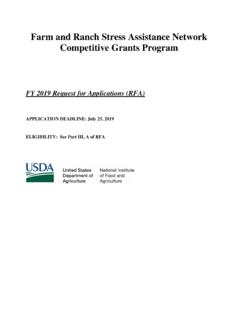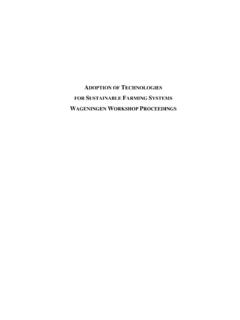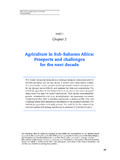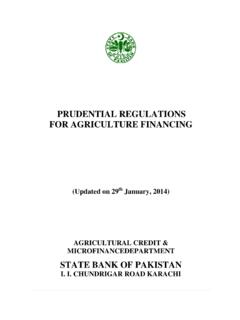Transcription of U.S. Farm Income Outlook for 2017
1 farm Income Outlook for 2017. Randy Schnepf Specialist in Agricultural Policy October 4, 2017. Congressional Research Service 7-5700. R40152. farm Income Outlook for 2017. Summary According to USDA's Economic Research Service (ERS), national net farm Income a key indicator of farm well-being is forecast at $ billion in 2017, up 3% from last year. The forecast rise in 2017 net farm Income comes after three consecutive years of decline from 2013's record high of $ billion. Net farm Income is calculated on an accrual basis.
2 Net cash Income (calculated on a cash-flow basis) is also projected to be up in 2017 but by a larger share ( ), driven largely by sales from previous years' inventory, to $ billion. The 2017 net farm Income forecast is substantially below the 10-year average of $ billion and would be the second lowest since 2003 in inflation-adjusted dollars. This is primarily the result of the Outlook for continued weak prices for corn, soybeans, and cotton. Most crops and livestock product prices remain significantly below the average for the period of 2011-2013, when prices for many major commodities attained record or near-record highs.
3 Net farm Income is down 49%. since 2013; net cash Income is down 26%. farm -sector production expenses have fallen slightly over that period (-1%) but not nearly as quickly as commodity prices and revenue, thus contributing to lower aggregate Income totals. Partially offsetting the decline in farm revenues is a rise in government payments since 2013. (+18%). In 2017, payments are projected at $ billion, down slightly ( ) from 2016. The Price Loss Coverage (PLC) and Agricultural Risk Coverage (ARC) revenue support programs for major field crops are expected to trigger payments of $ billion in 2017, up from 2016.
4 farm Income experienced a golden period during 2011 through 2014, due to strong commodity prices and agricultural exports. In 2017 agricultural exports are forecast to be up 8%, at $ billion, due largely to an improving economic Outlook in several major foreign importing countries but still well below 2014's record of $ billion. agricultural exports are projected to account for 33% of farm sector gross earnings in 2017. In addition to the Outlook for slightly higher net farm Income in 2017, farm wealth is also projected to be up 4% from 2016, to $3,075 billion.
5 farm asset values reflect farm investors' and lenders' expectations about long-term profitability of farm sector investments. The Outlook for slightly higher farm Income has reversed the decline in farmland values experienced in 2016. Because they comprise such a significant portion of the farm sector's asset base (81%), change in farmland values is a critical barometer of the farm sector's financial performance. At the farm household level, average farm household incomes have been well ahead of average household incomes since the late 1990s.
6 In 2015 (the last year for which comparable data were available), the average farm household Income (including off- farm Income sources) of $119,880 was about 51% higher than the average household Income of $79,263. The Outlook for a slight rise in net farm Income and farm wealth suggests that the farm economy has at least temporarily stabilized but with substantial regional variation. Relatively weak prices for most major program crops signal continued tough times ahead. Heading into 2018, the financial picture for the agricultural sector as a whole remains dependent on continued growth in domestic and foreign demand sources to sustain prices at current modest levels.
7 Improvements in agricultural economic well-being will hinge on crop harvests and prices, as well as both domestic and international macroeconomic factors, including economic growth and consumer demand. This report is an update of the February 2017 version to take account of USDA's August 30, 2017, farm Income update and the August 29, 2017, agricultural trade Outlook update. Congressional Research Service farm Income Outlook for 2017. Contents Introduction .. 1. USDA's 2017 farm Income Forecast .. 2. Selected Highlights.
8 2. Overview of Agriculture in 2017 .. 4. Crop Outlook .. 4. Livestock 6. Gross Cash Income 9. Crop Receipts .. 9. Livestock Receipts .. 11. Government Payments .. 13. Production Expenses .. 14. Cash Rental Rates .. 16. Agricultural Trade Outlook .. 17. Key Agricultural Trade Highlights .. 18. farm Asset Values and Debt .. 21. Average farm Household Income .. 23. On- farm vs. Off- farm Income Shares .. 23. Total vs. farm Household Average Income .. 24. Note on Aggregate farm Household Data .. 24. USDA Monthly farm Prices Received Charts.
9 26. USDA farm Income Data Tables .. 26. Figures Figure 1. Annual farm Sector Nominal Income , 1940 to 2017F .. 3. Figure 2. Annual farm Sector Inflation-Adjusted Income , 1940 to 2017F .. 3. Figure 3. Corn Stocks Relatively Abundant, Price Down in 2017F .. 5. Figure 4. Soybean Stocks-to-Use Share Up, Price Down in 2017F .. 5. Figure 5. Indexed farm -Price-to-Feed Ratios for Cattle, Broilers, Milk, and Hogs .. 6. Figure 6. The MPP Margin Projected to Remain Above $8/cwt. in 2017 .. 7. Figure 7. The Beef Cattle Inventory (Including Calves) Since 1960.
10 8. Figure 8. farm Cash Receipts by Source, 2000 to 2017F .. 9. Figure 9. Crop Cash Receipts by Source, 2008 to 10. Figure 10. Cash Receipts for Selected Crops, 2013-2017F .. 11. Figure 11. Livestock Product Cash Receipts by Source, 2008 to 12. Figure 12. Cash Receipts for Selected Animal Products, 12. Figure 13. Government farm Support, Direct Outlays, 1996 to 2017F .. 13. Figure 14. Total farm Production Expenses, 1970 to 2017F .. 15. Figure 15. Index of Prices Received versus Prices Paid, 1995 to 15. Figure 16. farm Production Expenses for Selected Items, 2016 and 2017F.















